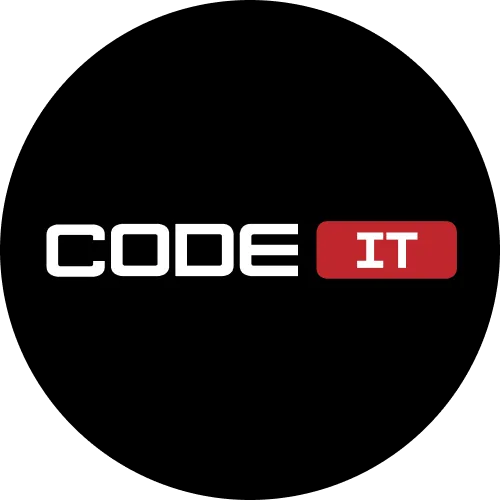Image Recognition Software: development, benefits, solutions

The human brain is an amazing part of our organism. From the very first days, the brain was accustomed to memorizing visual and sound images, actions and patterns, in order to build logical chains in the future. On a subconscious level, our brain helps us classify visual images, tag and retrieve data from them, recognize context, and so on. We have acquired all these skills evolutionally for hundreds of years of our existence.
However, even a system as powerful as our brain is limited. And although there are disputes about whether we are using it to the fullest or not, the fact is: when working with large amounts of data, our computing power, and recognition capabilities are relatively weak. That is why, with technological development, we decided to assign this task at the mercy of computer power. This is how the Image Recognition industry was born. Image recognition software and applications use AI and Machine Learning algorithms to fulfill Mark Zuckerberg’s dream someday and begin to recognize images better than humans do.
We invite you to plunge deeper into this topic and reflect on how useful the Image Recognition app can be and at what stage of its development this industry is at the moment.

What is Image Recognition software?
At its core, Image Recognition software performs the same functions as our brain. Thanks to sophisticated algorithms, a large amount of data, and machine learning technology, mobile picture recognition apps remember visual images and patterns in order to eventually capture the context, classify images, determine what is depicted on them and what actions are taking place.
In the technology of image recognition, both classical deep learning applications and AI-powered solutions are used. The latter win in the speed and quality of pattern recognition, since they are able to learn independently and memorize and classify a larger amount of data, while deep learning-powered solutions often compare the image with the internal data set.
In everyday life, Image Recognition applications are used in industries such as retail and healthcare software development, but the range of their appliance is much wider. In fact, any business can use such applications in order to provide more targeted content to their customers and increase User Experience in general.
Let’s look at the algorithm of the Image Recognition App in more detail.
Image Recognition process
In general, the process of Image Recognition begins with defining and categorizing an image and ends with defining the objects that are present in that image. In order to better understand how this happens, we have broken down the algorithm into several main stages.
Image detection
At this stage, the application determines the type of image and checks whether it is in a certain category or not. In case the image is in a certain category, the application proceeds to the next stage. Otherwise, the application compares this image with other images in order to determine the most accurate category.
Data classification
Having figured out which category the image is in, the application proceeds to classify depictured data. The application determines the size, color, aspect ratio, as well as objects that are depicted on it. Images in the application are categorized by tags, and therefore the new image is also assigned a corresponding tag after the comparison process. This will help to accurately determine the essence and type of the image in the future.
Important characteristic detection
The next step is to define the main feature of the image. It can be anything and can be used both for more accurate recognition and for a more improved customer UX. Depending on the task, the application either determines whether the image contains a feature that may be of interest to the user or not. Or it independently determines the main feature based on the previously defined main features in images with this tag or from this category.
Image information extraction
The penultimate stage at which the application must understand the essence of the image. To do this, based on all the data obtained in the previous stages, the application determines all the objects in the image. The data used must be clearly defined, labeled, and distributed so that the application can recognize it in a new image, such as a “red bike” or “fire engine”. All these data are extracted in order to complete the Image Recognition process at the last stage.
Image classification
Finally, after extracting and processing all available information and comparing it with existing images and categories, the application can classify the image, assign it the appropriate tag and category, and also classify all those objects and actions that are depicted in the image.
This is a slightly superficial description of the Image Recognition process, and it can vary depending on the specific application, but the basic essence remains the same.
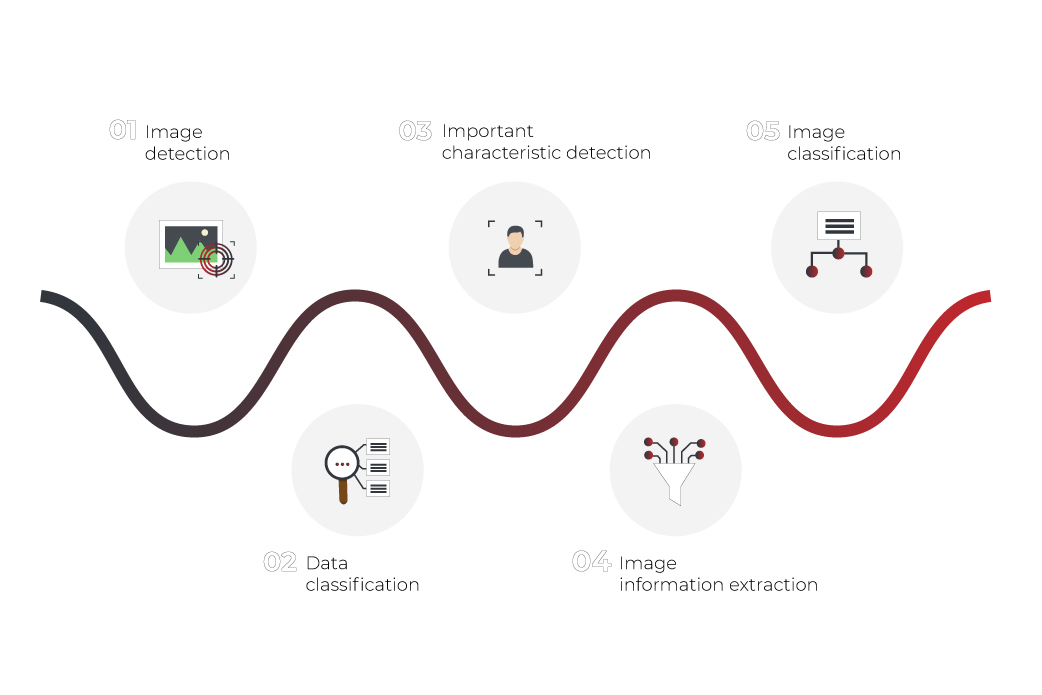
Image Recognition software benefits
It is logical to assume that since this technology is invested, it means that it is beneficial. It’s time to talk about exactly what benefits the Image Recognition applications give to the business and what are the prospects for this technology in the designated markets.
Enhanced product tagging & visual search
A good Photo Recognition App usually has an internal catalog of images, which are distributed according to some criteria. After that, each image is assigned a corresponding tag. With that, the application will be able to quickly find matches between new and existing images in the future. Ultimately, this feature will allow both to quickly identify and tag images, and to speed up the visual search process for customers.
Greater UX and audience engagement on social platforms
Social platforms are an excellent testing ground for new Image Recognition technologies. Social platforms attract users to personally place tags on uploaded photos and designate their friends on them. Thanks to the analysis of hundreds of thousands of such photos and attached tags, the AI algorithms of social platforms are constantly being trained and are now ready to independently designate tags for uploaded photos and determine those emotions or actions that are depicted on them.
Enhanced targeting in marketing activities
Mobile app marketing is a challenge faced by any business, one way or another existing in the industry. Image Recognition technology is, in fact, another tool in this activity, allowing to create more relevant and targeted marketing algorithms. So, one of the most popular directions is the ability for the user to take a photo of something and, using the application, go directly to the purchase of this product (or get additional information about the product). Big companies like Amazon and Macy’s are already using these technologies to boost their sales.
Better analysis of customer needs
Text content is gradually, but very confidently, giving its position to video and graphic content in the context of marketing promotion. In such a situation, it is absolutely logical to strive to get more insights from what graphic and video content is published and shared by customers. That is why Visual Listening becomes a key factor in understanding the needs of customers, and picture recognition software is the key to collecting, analyzing, and prioritizing visual content.
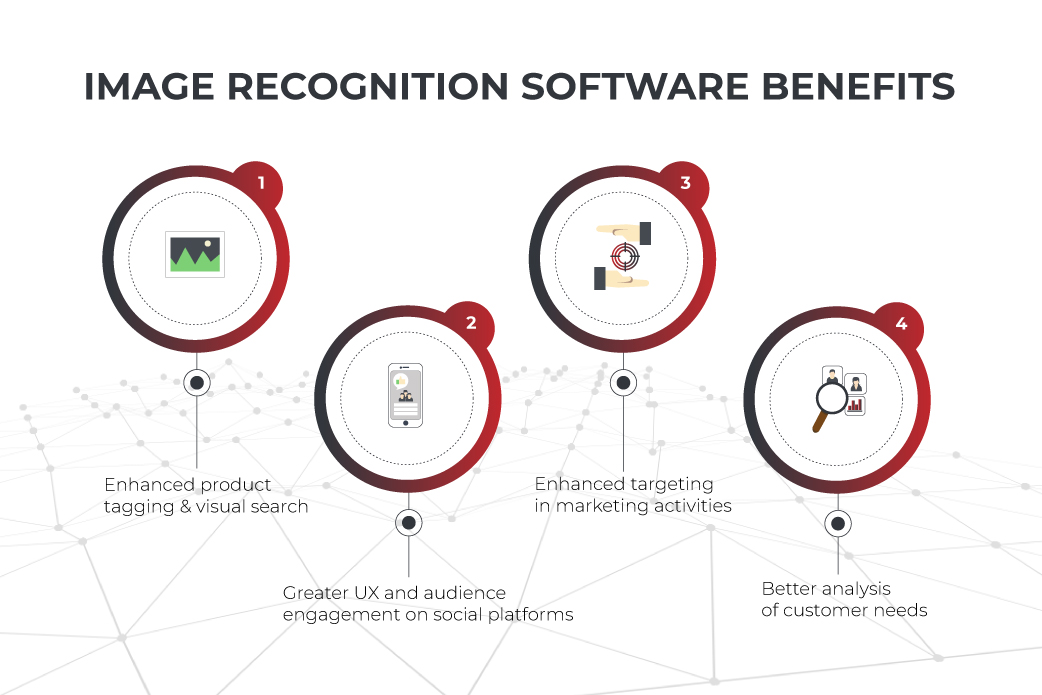
Which Image Recognition API should you choose?
There are no trifles in the Image Recognition app development. While you can invest in the creation of a full-fledged team of engineers and AI specialists who will develop an engine that will allow your picture recognition software to become a truly high-quality app, it is much faster and smarter to turn to existing solutions.
Large companies (and not only) have been investing in this trend for a long time, and therefore the choice of the existing API will significantly speed up the process of picture identification app development. We offer you some of the most famous and quality options to choose from.
Google Cloud Vision. Using powerful Google AI algorithms and extensive data, Cloud Vision is one of the most popular APIs on the market. The functionality that this API offers is capable of performing the most popular actions of the Image Recognition application, such as analyzing objects, identifying explicit content, etc. One of the most interesting features of this API is the recognition of text, both typed and handwritten. This allows you to upload text directly from the photo and instantly process it digitally. The capabilities of Cloud Vision are truly amazing, but the price for using this API is appropriate.
Amazon Rekognition. Like the previous solution, Amazon Rekognition has all the necessary set of functions to create a full-fledged photo identifier app. This API is in no way inferior to the previous one, and the choice between them must be made based on the specifics of the tasks set. Speaking of them, one of the features worth highlighting is the ability to analyze text and objects in motion. Thus, with Amazon Rekognition, you can reach a new level of video analysis. As for payment, the API can be tried for free, and the payment system is extremely flexible, which can also be marked as a benefit.
IBM Watson. Unlike the previous API, the IBM solution is a little more difficult to install and add on, but it offers much more extensive customization. The engineers who bought this solution will be able to build or train the system on their own, while in the previous two cases, these processes are rather automated and more versatile. But if you need sophisticated customization, then IBM Watson is exactly your choice between the three. Despite this, the API has several pre-installed algorithms for basic image analysis for the presence of prohibited content, some objects, and their specifics.
Imagga. Imagga was created primarily to process and tag a huge number of images. The functionality of this API is slightly less than that of other APIs from this list. This is due to the fact that Imagga is a relatively new image recognition technology and is a much more budgetary option than the three other APIs that we talked about earlier. Working with tags and data inside Imagga is simple, as the API provides a simple intuitive UI and easy search and filtering functions.
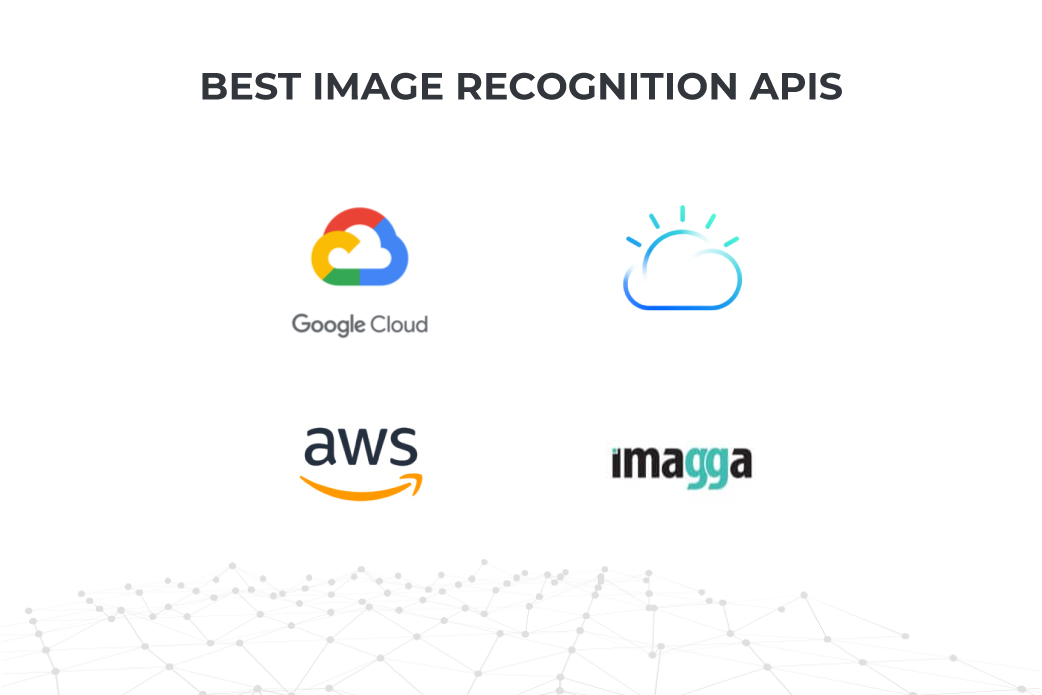
These are far from all the options available in the Image Recognition API matter, but we have chosen a few basic ones in order to shape your direction in your search.
Image Recognition Apps to consider
If you are not eager to start developing a custom solution, you can always turn to the market for off-the-shelf applications. Fortunately, as in the case of the API, both well-known industry giants and smaller companies have created their picture recognition apps, and therefore you will have a wide choice.
Google Lens
How can a Google app work? Well, of course, everything is geared towards Google search, only now the process is going the other way around. With this application, you can take a photo of anything, after which the Image Recognition algorithms of the application recognize the information and objects in the photo and give you a list of search results for everything that was found in the image. Google’s image recognition app is one of the leading choices among the other apps in the industry.
Vivino
This application has a narrower and more industry-related range of appliances, but that does not negate its greatness. Due to the fact that the Image Recognition algorithm is able to provide users of the application with a similar wine to the one that was photographed, this application is the leader among the segment of wine applications. In addition, inside you will find all the standard set of functions, such as providing all available information about the photographed wine, including the price.
PictureThis
Like the previous example, this app is highly targeted and focused on plants. Thanks to it, you can now take a picture of any plant and get all the available information on it, including the rules of care. This becomes possible thanks to the vast database of the most diverse and rare plants, which is stored inside the application.
Zebra Medical Vision
Zebra Vision is one of the best medicine apps, as it helps to evaluate X-rays and other medical data for possible oncology and other pathologies. Of course, all this data is rechecked many times, but already at the first stages, the application can significantly speed up and simplify the work of doctors.
TapTapSee
TapTapSee was conceived as an assistant for visually and hearing-impaired people. All you need to do is take a picture of any object and the application identifies the picture and in text or voice form will explain to you what exactly you photographed.
Amazon Flow
How often have you come across the fact that you saw a thing and dreamed of finding it on Amazon? This is no longer a problem, thanks to Amazon Flow. Take a photo of the product you like and the application will find it for you on the site if it is there. And yes, this is the only problem with the app: if the product or thing you photographed is not on Amazon, then the app will not be able to help you. On the other hand, what might not be on Amazon nowadays, right?
CamFind
CamFind is another example of one of the best image recognition app ideas. It takes Google Lens principles and skyrockets them to the next level. It’s literally a search thanks via your camera. Just take a photo of anything and the application will give you results in the form of links, text, image, and video content corresponding to what you photographed. Save the results you like to your profile and find them later in Google or offline stores.
ScreenShop
The dream of all fashionistas, you can finally find the things that the actors in your favorite movie wear. Just take a screenshot or a photo of the clothes you like and the application will analyze the picture in order to tell you the best ways where you can buy those jeans, long sleeves, and jackets that you like so much.
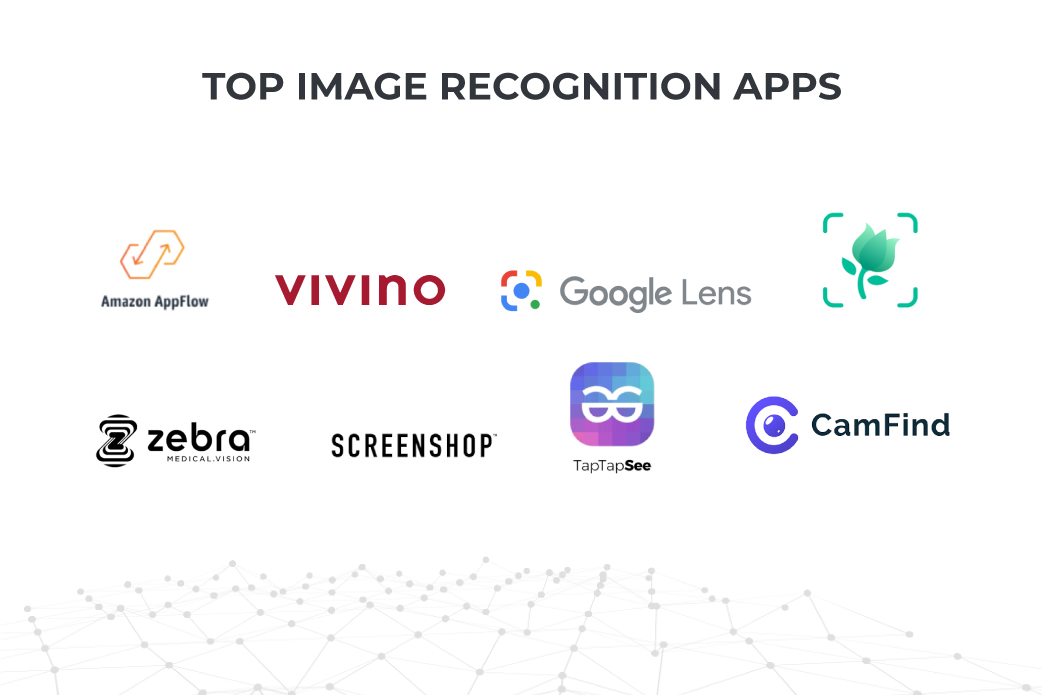
Bottom Line
You might think that at the moment the Image Recognition technology is used mainly in the retail, eCommerce, and healthcare industries. This is partly true, but only because this technology was adopted there in the first place. In the future, we can expect the emergence of Image Recognition solutions even in industries such as FinTech, because in fact, the development of this technology is limited exclusively by technical frames. We will undoubtedly see new solutions emerge soon.
FAQ
Image Recognition app uses AI algorithms as well as machine and deep learning technologies. Most often, the application compares the seen application with the extensive database already stored in it (this is what Google Lens does, for example) in order to analyze what kind of image it is and what objects are depicted on it.
Using its internal API, Google has developed a special Google Lens application that you can install on your mobile phone. After that, you just need to take a photo of something and the application will give you a list of search results according to what it finds in the image. In fact, it’s like Google images search just the other way around.
This process allows computer technology to perform the function of our brain. Namely, analyze the image, identify the objects and actions that are depicted on it, grasp the context and build logical patterns based on what we have already seen. It is this process, only very quickly and in much larger volumes, that is called Image Recognition.
Build your ideal
software today

